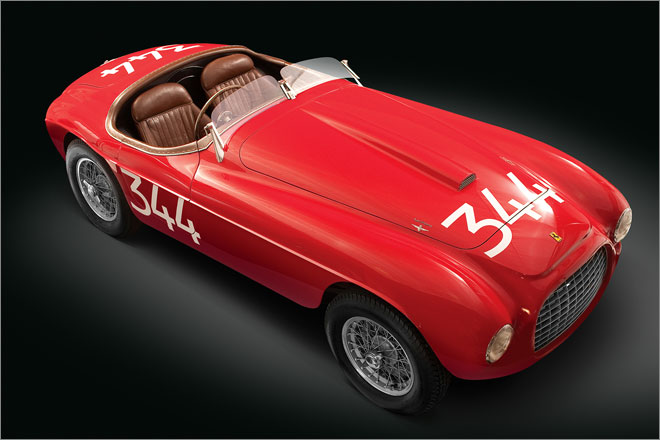SCM Analysis
Detailing
| Vehicle: | 1949 Ferrari 166 MM Barchetta |
| Number Produced: | 25 |
| Original List Price: | $9,000 |
| Chassis Number Location: | Stamped on the left side frame rail next to the engine |
| Engine Number Location: | Stamped on a flange on the rear passenger side of block. Note: early Ferrari engine numbers match but are two numbers less than the chassis number. |
| Website: | http://www.FerrariClubofAmerica.org |
| Alternatives: | 1949 Cisitalia 202MM Nuvolari Spyder, 1953-55 Fiat 8V Zagato, 1947-53 Maserati A6GCS |
This car, Lot 285, sold for $1,870,000 at RM’s Phoenix, AZ, auction on January 21, 2011.
It is to be expected that a 1949/1950s vintage Ferrari might be light on authenticity and even lighter on documentation, but 166 Barchetta #0024M is an exception. Through good conversation—and saved paperwork—by a couple of previous owners, as well as Ferrari historian Stan Nowak’s exceptional efforts, virtually all the history of 0024M is known, and all the original components have been reunited with the car. With the exception of the original body, 0024M is nearly true to its original configuration, and few apologies need to be made for its current condition.
$1,870,000 is a lot of money to most people, but it was a disappointingly light sale for this 166 Barchetta. The Barchetta didn’t even break the low number of the $1.9m to $2.9m pre-auction estimate. The January Arizona auction circus clashes with the very popular and well attended Cavallino Classic Ferrari event in Florida, and that may have stifled some interest. Many big Ferrari collectors would rather spend the weekend with friends than fight the Arizona crowds to spend a couple of million dollars.
A few other factors may have kept the number low. One Barchetta expert I consulted was very high on the car, but he noted that 0024M has been on the market since 2007—and flogged all over the world. He said that the asking price started out at $4.5m, which was way too much for the car. He said that the rebody was good, but it still left a little to be desired.
This car has apparently has been sold a couple of times since 2007, and I suspect these sales were for more than it brought at this auction. Too much activity is not good for an important car. Many of this Ferrari’s potential buyers had already been offered the car, and its availability was yesterday’s news.
A future trip to Italy?
Like it or not, Ferrari Classiche certification is now a factor in the value of important Ferraris. The newest version of the program is more realistic than the original. Ferrari now grants conditional certificates to some historically correct cars that are not able to meet the rigorous originality standards. The conditional certificates allow important race cars or in-period modified Ferraris to be certified without returning them to factory configuration.
A conditional certificate is an approval of the car—with an explanation of why the car doesn’t meet full certification. Scores of Ferraris have been certified, and even the critics of the program can’t deny that certification is becoming an important part of a buyer’s criteria. Most cars can be certified with the assistance of a local dealer.
Barchetta 0024M had been undergoing Ferrari Classiche certification, but the process was not complete at the time of the auction. Ferrari wanted the car shipped to Italy for inspection before they would certify it. The request to send 0024 M to the factory is an ominous sign that Ferrari suspects a problem that will require their assistance—and the owner’s money—to correct.
In the end, the buyer got a deal on 0024M. It is one of only a handful of the 166 Barchettas, an immensely desirable model. It is well known in the Ferrari community—and is accepted as a legitimate car without reservation. It should only require minor tweaking to pass Ferrari Classiche certification. It is in restored condition, and while it isn’t in Pebble Beach-winner condition, all the expensive work has been done. This is a blue-chip car at a fair price that will only appreciate with time. Call this one well bought.
